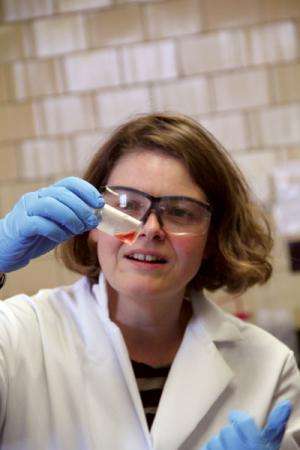U.S. Department of Energy's Ames Laboratory and Critical Materials Institute materials chemist Anja Mudring is harnessing the promising qualities of ionic liquids, salts in a liquid state, to optimize processes for critical materials.
"Ionic liquids have a lot of useful qualities, but most useful for materials processing is that ionic liquids are made up of two parts: the cation and the anion. We can play around with the chemical identities of each of those components and that opens the doors to huge amount of options," says Mudring. "That means we can really engineer ionic liquids with specific functions in mind."
One such function is improving the rare-earth separation process, either for extracting rare earths from ore or recycling rare earths from discarded magnets.
"We are tuning the ionic liquids in such a way that they dissolve rare-earth oxides and then we're using electrodeposition, where electricity is run through a liquid to create a chemical change to get the rare earth in metal form," says Mudring, who is also a professor of materials science and engineering at Iowa State University.
Traditionally, electrodeposition processes are extremely high temperature and often require corrosive chemicals. But Mudring's process requires much lower temperatures and ionic liquids are less hazardous, so less energy is needed and the process is safer and greener.
Mudring's group is also using ionic liquids to create phosphors for compact fluorescent light bulbs.
"We're using ionic liquids, putting them in a microwave, energizing them, and creating a phosphors material. The phosphors particles are less than 10 nanometers, which means they do not scatter light, key for optical applications like for compact fluorescent light bulbs," says Mudring.
Better yet, Mudring's process also reduces the amount of rare-earth materials required in the process, and may someday make it possible to replace mercury vapor with less-hazardous noble gases in CFLs. And looking farther down the road, the new phosphors could also be used in LEDs as they continue to replace CFLs.
"Ionic liquids are the key to the improvements in this material synthesis," says Mudring. "They function as the solvent, a safer one than an alcohol or other combustible solvent. And they are also the reaction partner: Here, the ionic liquid is the fluoride source, so we can omit hazardous hydrofluoric acid from the process. Again, that makes the process safer and cleaner. And they even function to stabilize the nanoparticles created in the process, eliminating the need for an additional stabilizer. Three functions in one! Add to that how efficiently ionic liquids take up microwave energy and there's just huge potential there for improving materials synthesis."
Provided by Ames Laboratory
























